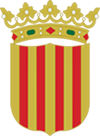|
The Kingdom of Aragon began as a tiny Frankish feudal county at the foothills of the Pyrenees Mountains. (See map 1 - 1050 AD) This tiny polity played an important role in the reconquista of Spain from the moors, conquering Huesca in 1096 and Zaragoza in 1118. (See map 2 - 1120 AD) In 1150, Aragon was joined with the County of Barcelona through dynastic union, which led to the acquisition of the major Mediterranean ports of Catalonia. (See map 3 - 1150 AD).  Shield of the Crown of Aragon During the 1300s, the Crown of Aragon embarked on even more aggressive expansion. In 1323, Aragon invaded Sardinia. At that time Sardinia was divided into a number of small fiefdoms called the Guidicati. The Aragonese allied themselves with the Guidicati of Arborea in central Sardinia, and were able to conquer all of the other Guidicati and add most of Sardinia to the Crown. The Central portion remained under the Guidicati of Arborea for a time. (See map 5 -1330 AD) The Aragonese also involved themselves in the affairs of Greece, a number of Aragonese adventurers known as the 'Catalan Company' had offered their services as mercenaries to the Duke of Athens. When the Duke refused to pay them, they slew him at the Battle of Halmyros in 1311 and took over the Duchy of Athens, making Catalan the official language and eventually passing control of it directly to the Crown of Aragon. By this time, the Crown of Aragon could be considered a major Mediterranean Thalassocracy, controlling territory in both the Western and Eastern Mediterranean. (See map 5 - 1330 AD) In 1390, the Duchy of Athens was sold to the Acciaioli family of Florence. The Crown of Aragon then concentrated it's efforts on expansion in the Western Mediterranean. In 1409, the forces of Eleanor of Arborea were defeated at the Battle of Sanluri, leading to Aragonese control of the entire island of Sardinia. The Aragonese then began a brutal conflict with the city-state of Genoa over the control of the island of Corsica. (See map 6 - 1415 AD) The Aragonese were unable to conquer the entire island and eventually withdrew. The last major expansion of the Crown of Aragon was in Italy, when Alfonso V conquered the Kingdom of Naples in 1442. (See map 7 - 1450 AD) In 1474 Ferdinand II of Aragon married Isabella I of Castile and the Kingdom of Aragon was merged with the Kingdom of Castile, eventually this joint Kingdom would evolve into the modern nation of Spain. Nevertheless, the people of Catalonia have to this day maintained an independent identity and language. |



